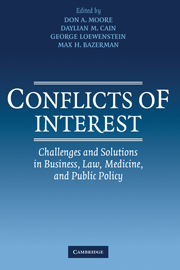Book contents
- Frontmatter
- Contents
- List of Contributors
- Acknowledgments
- Introduction
- PART ONE BUSINESS
- PART TWO MEDICINE
- PART THREE LAW
- 13 Legal Responses to Conflicts of Interest
- 14 Commentary: Conflicts of Interest Begin Where Principal–Agent Problems End
- 15 Conflicts of Interest and Strategic Ignorance of Harm
- 16 Commentary: Strategic Ignorance of Harm
- PART FOUR PUBLIC POLICY
- Index
- References
13 - Legal Responses to Conflicts of Interest
Published online by Cambridge University Press: 04 August 2010
- Frontmatter
- Contents
- List of Contributors
- Acknowledgments
- Introduction
- PART ONE BUSINESS
- PART TWO MEDICINE
- PART THREE LAW
- 13 Legal Responses to Conflicts of Interest
- 14 Commentary: Conflicts of Interest Begin Where Principal–Agent Problems End
- 15 Conflicts of Interest and Strategic Ignorance of Harm
- 16 Commentary: Strategic Ignorance of Harm
- PART FOUR PUBLIC POLICY
- Index
- References
Summary
Conflicts of interest abound in the law. The core attorney–client relationship is a classic example of a principal–agent relationship, with all the attendant and endemic tensions and risks of opportunistic behavior. The basic legal definition of attorney, as set forth in the standard law reference, “denotes an agent or substitute, or one who is appointed and authorized to act in the place or stead of another” (Black, 1951). The ability to act on behalf of another of itself creates conflicts that are “intrinsic to the exercise of trust” (Shapiro, 2003). Much of legal regulation, including that directed at attorney–client relations, attempts to mediate the conflicts inherent in a world where dependence on agents is the norm.
This chapter will assess distinct legal responses to conflicts of interest. The aim will not be to catalogue the range of conflicts that the law recognizes or to identify all of the various regulatory responses that may be tried. Rather, the object will be to use a couple of examples of significant conflicts of interest, whether labeled as such or not, to map the types of regulatory methodologies that may be employed. By mapping different responses to conflicts of interest onto certain regulatory patterns, the costs and benefits of different approaches can be assessed. In particular, identifying the range of regulatory responses may help clarify the competing tensions that exist in principal–agent relations, such as that between attorney and client.
- Type
- Chapter
- Information
- Conflicts of InterestChallenges and Solutions in Business, Law, Medicine, and Public Policy, pp. 189 - 201Publisher: Cambridge University PressPrint publication year: 2005
References
- 7
- Cited by



